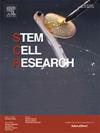从患有 CLN3 相关疾病的人的成纤维细胞中提取的六种诱导多能干细胞系
IF 0.8
4区 医学
Q4 BIOTECHNOLOGY & APPLIED MICROBIOLOGY
引用次数: 0
摘要
通过表达四种重编程因子:人类 OCT3/4、KLF4、SOX2 和 c-MYC,利用六名 CLN3 相关患者的原代成纤维细胞生成了诱导多能干细胞(iPSC)系 CHDTRi001-B、CHDTRi002-B、CHDTRi003-A、CHDTRi004-B、CHDTRi005-A 和 CHDTRi006-E。通过免疫细胞化学、流式细胞术和畸胎瘤的形成对这些 iPSC 株系进行了鉴定,以确认它们的多能性。基因组稳定性、细胞系特性和 CLN3 基因型也得到了确认。CLN3是一种罕见的致命性儿科失明和神经退行性溶酶体疾病,目前尚无治愈方法。本文章由计算机程序翻译,如有差异,请以英文原文为准。
Six induced pluripotent stem cell lines from fibroblasts of individuals with CLN3-related conditions
Primary fibroblasts from six individuals with CLN3-related conditions were used to generate induced pluripotent stem cell (iPSC) lines CHDTRi001-B, CHDTRi002-B, CHDTRi003-A, CHDTRi004-B, CHDTRi005-A, and CHDTRi006-E through the expression of four reprogramming factors: human OCT3/4, KLF4, SOX2, and c-MYC. The iPSC lines were characterized to confirm their pluripotency via immunocytochemistry, flow cytometry, and teratoma formation. Genomic stability, cell line identity, and CLN3 genotype were confirmed. These iPSC lines may be used as participant-derived experimental models for further investigation of CLN3, a rare, fatal, pediatric, blindness and neurodegenerative lysosomal disorder with no cure.
求助全文
通过发布文献求助,成功后即可免费获取论文全文。
去求助
来源期刊

Stem cell research
生物-生物工程与应用微生物
CiteScore
2.20
自引率
8.30%
发文量
338
审稿时长
55 days
期刊介绍:
Stem Cell Research is dedicated to publishing high-quality manuscripts focusing on the biology and applications of stem cell research. Submissions to Stem Cell Research, may cover all aspects of stem cells, including embryonic stem cells, tissue-specific stem cells, cancer stem cells, developmental studies, stem cell genomes, and translational research. Stem Cell Research publishes 6 issues a year.
 求助内容:
求助内容: 应助结果提醒方式:
应助结果提醒方式:


